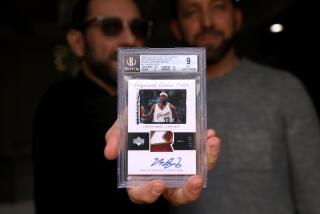Upper Deck’s in a Slump, Chief Says : Card Firm President Gives Financial Stats in Court
- Share via
SANTA ANA — If Upper Deck were a baseball player, the sports trading card company’s best season would have been 1991, when, according to court testimony revealed this week, the young, privately held company generated an astounding $66.7 million in dividends.
Upper Deck’s all-star performance was even more incredible coming during the start-up company’s third year in the highly competitive trading card business.
The Carlsbad company is generally credited with revolutionizing the industry with the introduction of its upscale line of sports trading cards in 1989. That year, Upper Deck, which generally doesn’t break out its profit or revenue figures, reported paying $4 million in dividends to its owners. In 1990, dividends soared to $35 million.
By 1991, with sports card trading at its peak nationwide--and Upper Deck still dominating the premium card niche that it created--the company’s dividends hit $66.7 million on $263.3 million in sales.
Upper Deck’s dramatic growth slowed in 1992, however, after Major League Baseball and other professional sports organizations awarded card licenses to dozens of competitors who flooded the sports collectibles market with an astounding array of new products, including several brands that compete directly with Upper Deck’s premium cards.
Sales last year after returns and discounts were flat at $263.2 million, but dividends fell 31% to $45.7 million. The slow sales have continued: Net sales for the first quarter ended Feb. 28 fell to $68 million, down from $103 million a year earlier.
Upper Deck in mid-April stopped production for a month at its 2-year-old printing plant in Carlsbad, Upper Deck President Richard McWilliam said Tuesday. He said the company was hoping to “give the market a breather.”
McWilliam’s candid comments on his company’s financial performance were highly unusual, because McWilliam, who owns 26% of Upper Deck, has successfully shielded the private company’s financial status from public scrutiny. McWilliam broke his self-imposed silence Tuesday morning as he testified in an ongoing civil trial in Santa Ana Superior Court.
Last week, a 12-member Santa Ana jury sided with an Orange County attorney who maintained that he owned a 3% share of the company that was started in Yorba Linda in 1988. As early as today, the jury will begin deliberations on possible financial damages for plaintiff Andrew Passante Jr., who served as Upper Deck’s first corporate secretary.
McWilliam testified, in part, to counter testimony by an expert witness for Passante, who set Upper Deck’s market value on Dec. 31, 1992, at an astronomical $1.5 billion. Upper Deck’s value is important because Superior Court Judge James Cook might allow jurors to determine the value of Passante’s shares based on that figure.
While on the stand, McWilliam estimated the market value of Upper Deck at about $250 million and said that Upper Deck’s printing plant will return to full production later this month. He also described two ill-fated attempts to expand Upper Deck’s product line beyond its core sports cards.
Despite these problems, Upper Deck remains a leader in the $1.8-billion trading card industry, said Paul Much, a senior vice president with Houlihan Lokey Howard & Zukin, a Los Angeles company that appraises the value of companies. “We’re not talking about survival (at Upper Deck). . . . What we’re talking about is a lack of growth.”
According to industry observers, sales growth is an industrywide problem for sports trading card companies. Fierce competition is causing problems for several longtime market leaders--and many relative newcomers.
Brooklyn, New York-based Topps Co., which began selling baseball cards in 1951, reported a $2.1-million net loss for the quarter ended Feb. 27--reportedly its first quarterly loss in more than a decade.
Shares of Topps and some other publicly traded sport cards producers, including New Jersey-based Score Board Inc., have tumbled in value by 50% or more.
Slow sales and escalating costs recently forced Dallas-based Pro-Set Inc., which produces entertainment and music industry trading cards, into bankruptcy court. A handful of other card manufacturers--including Star Pics, Line Rock International, Ultimate and Smokey’s--have gone out of business, said Much, who testified Tuesday on behalf of Upper Deck.
That picture is in stark contrast to 1991, when the sports trading card business “was like printing money . . . everything you could print was bought out by the public,” said David Kohler, owner of Laguna Niguel’s Sports Cards Plus, a trading card and sports memorabilia retailer.
Card trading, long dominated by hobbyists, rapidly evolved into “an investment-driven industry” where well-heeled investors bought trading cards as an investment opportunity, said Lou Costanzo, executive director of the Sports Collectibles Assn. International, a trade organization that represents card retailers, manufacturers and major sports leagues.
Card company revenues skyrocketed as doctors, lawyers and other professionals purchased cases of unopened cards, “sticking it in their garage with the expectation that it would appreciate in value,” McWilliam said.
Now, investors buy specific cards--including rookie cards featuring National Basketball Assn. rookie sensation Shaquille O’Neal of the Orlando Magic, which already have jumped in value.
Some card manufacturers--including Upper Deck--also got burned when they attempted to expand beyond cards.
Upper Deck took a $15-million loss when a line of trading cards featuring Bugs Bunny and Daffy Duck bombed with youngsters. Upper Deck also suffered a “significant failure,” McWilliam said, when consumers ignored a classy wall poster featuring the “Dream Team,” the United States’ gold-medal Olympics basketball team. Upper Deck absorbed an additional $6-million loss when retailers returned 75% of the posters.
Kids’ Stuff Is Now Big Business
The childhood pastime of collecting baseball cards has become a nearly $2-billion-dollar business, with cards available for nearly every pro sport. But with new companies cranking out cardboard, some are getting lost in the shuffle. The fiscal-year picture for four card-industry players (in millions):
Upper Deck Topps Fleer Headquarters Carlsbad, CA Brooklyn, N.Y. Philadelphia Founded 1989 1950 * 1913 1991 Revenues ***$263.2 $290.0 $161.6 1991 Profits ****$66.7 $54.1 $23.4 1992 Revenues ***$263.2 $303.2 $175.0 1992 Profits ****$45.7 $54.4 $21.6 1993 Revenues n/a $263.2 ** 1993 Profits n/a $19.0 **
Score Board Headquarters Cherry Hill, N.J. Founded 1986 1991 Revenues $33.3 1991 Profits $2.8 1992 Revenues $58.6 1992 Profits $6.0 1993 Revenues $75.3 1993 Profits $8.0
* Founded in 1913 as a confectionery firm. Entered sports card business in 1981.
** Fleer was acquired by Marvel Entertainment in 1992 and no longer reports its finances separately.
Note: Upper Deck is a privately held company; available data obtained from court records and interviews.
*** Net sales: Includes returned items and discounted products.
**** Dividends: Amount returned to private stockholders.
Source: Individual companies; Researched by JANICE L. JONES / Los Angeles Times
More to Read
Go beyond the scoreboard
Get the latest on L.A.'s teams in the daily Sports Report newsletter.
You may occasionally receive promotional content from the Los Angeles Times.










